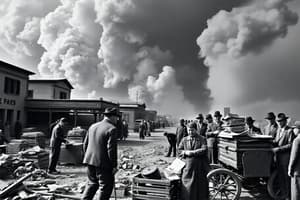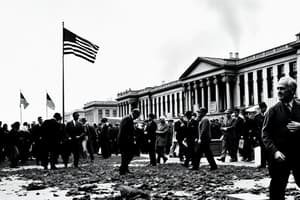Podcast
Questions and Answers
What was a major consequence of the Wall Street crash?
What was a major consequence of the Wall Street crash?
- Major losses for shareholders (correct)
- Stabilization of the banking system
- Increase in consumer demand
- Rise in stock market speculation
Which factor contributed to the agricultural depression in the 1920s?
Which factor contributed to the agricultural depression in the 1920s?
- Increased agricultural production during the war
- Rise in consumer purchasing power
- Decrease in European agricultural exports
- Excessive land purchases by farmers (correct)
How did overproduction in the USA contribute to the Great Depression?
How did overproduction in the USA contribute to the Great Depression?
- Most industry shifted towards luxury goods
- It resulted from increased consumer purchasing power
- Many consumers could not afford goods (correct)
- Markets in Europe were flourishing
What major shift in the economy occurred due to World War I?
What major shift in the economy occurred due to World War I?
What was one of the direct impacts of declining consumer demand?
What was one of the direct impacts of declining consumer demand?
How did the lack of banking regulations contribute to the Wall Street crash?
How did the lack of banking regulations contribute to the Wall Street crash?
What role did the global trading system play in the Great Depression?
What role did the global trading system play in the Great Depression?
What was a consequence of bank runs during the Great Depression?
What was a consequence of bank runs during the Great Depression?
What was the purpose of the Agricultural Adjustment Agency?
What was the purpose of the Agricultural Adjustment Agency?
Which act increased tariffs in the United States in 1930?
Which act increased tariffs in the United States in 1930?
What was a major effect of deficit spending in Nazi Germany?
What was a major effect of deficit spending in Nazi Germany?
What economic strategy did Nazi Germany pursue to reduce dependency on global trade?
What economic strategy did Nazi Germany pursue to reduce dependency on global trade?
How did the Great Depression impact militarist powers like Nazi Germany?
How did the Great Depression impact militarist powers like Nazi Germany?
Which statement best describes U.S. policy during the Great Depression?
Which statement best describes U.S. policy during the Great Depression?
What was a significant consequence of the withdrawal of U.S. capital after the Wall Street Crash?
What was a significant consequence of the withdrawal of U.S. capital after the Wall Street Crash?
What was a common characteristic of protectionist policies in the 1930s?
What was a common characteristic of protectionist policies in the 1930s?
What led to the public support of Nazi economic policies in the 1930s?
What led to the public support of Nazi economic policies in the 1930s?
What led to 'currency runs' during the Great Depression?
What led to 'currency runs' during the Great Depression?
Which approach did socialist Chancellor Hermann Mueller take to address unemployment benefits?
Which approach did socialist Chancellor Hermann Mueller take to address unemployment benefits?
How did governments try to maintain confidence in their currencies during the Great Depression?
How did governments try to maintain confidence in their currencies during the Great Depression?
What change occurred in government policy under President Hindenburg and Chancellor Bruening?
What change occurred in government policy under President Hindenburg and Chancellor Bruening?
What was the purpose of deficit spending during the Great Depression?
What was the purpose of deficit spending during the Great Depression?
Which action was taken by U.S. banks following the Wall Street Crash?
Which action was taken by U.S. banks following the Wall Street Crash?
What was a characteristic of the gold standard during the 1920s?
What was a characteristic of the gold standard during the 1920s?
Flashcards
Deficit Spending
Deficit Spending
Government spending more money than it collects in taxes, often to stimulate the economy.
Free Trade
Free Trade
A system where countries reduce tariffs and encourage international trade to boost economic growth.
Protectionism
Protectionism
A policy that aims to protect domestic industries by raising tariffs on imports.
Autarky
Autarky
Signup and view all the flashcards
U.S. Isolationism
U.S. Isolationism
Signup and view all the flashcards
Imperialist Agenda
Imperialist Agenda
Signup and view all the flashcards
FDR's New Deal
FDR's New Deal
Signup and view all the flashcards
The Great Depression
The Great Depression
Signup and view all the flashcards
Currency Runs
Currency Runs
Signup and view all the flashcards
Gold Standard
Gold Standard
Signup and view all the flashcards
Balanced Budget Policy
Balanced Budget Policy
Signup and view all the flashcards
Deflationary Policies
Deflationary Policies
Signup and view all the flashcards
Withdrawal of U.S. Capital
Withdrawal of U.S. Capital
Signup and view all the flashcards
Restricted Foreign Loans
Restricted Foreign Loans
Signup and view all the flashcards
Collapse of Credit-Anstalt
Collapse of Credit-Anstalt
Signup and view all the flashcards
Agricultural Depression
Agricultural Depression
Signup and view all the flashcards
Overproduction
Overproduction
Signup and view all the flashcards
Wall Street Crash
Wall Street Crash
Signup and view all the flashcards
Buying Stocks on Margin
Buying Stocks on Margin
Signup and view all the flashcards
Bank Runs
Bank Runs
Signup and view all the flashcards
Global Impact of the Great Depression
Global Impact of the Great Depression
Signup and view all the flashcards
Decline in Consumer Demand
Decline in Consumer Demand
Signup and view all the flashcards
Study Notes
The Great Depression and its Impacts
- Timeline: 1929-1939
- Economic Indicators:
- Drastic decline in output
- Acute deflation
- High unemployment (25% in 1932 in US)
- Industrial production decline (47% US, 44% Germany, 37% in the rest of the world - excluding the Soviet Union)
Beginnings of the Depression
-
Agricultural Depression (1920s):
- Increased agricultural production after World War I, exceeding demand.
- Prices fell, leading to debt and crisis for farmers.
-
Overproduction in the USA:
- Consumer goods production exceeded consumer demand, leading to reduced purchases.
- Limited European markets caused domestic overproduction issues.
- Those who could afford goods did not buy as much as needed
-
Decline of Traditional Industries:
- Coal industry faced competition from oil, leading to reduced demand and profits.
- Textile industry declined, with less demand for traditional fabrics.
-
Wall Street Crash (1929):
- Stock market speculation created a bubble.
- Stocks lost almost half their value in two months, causing significant losses for investors.
- This led to banking crisis.
Impact on the Banking System
-
Bank Failures and Savings Loss:
- Bank closures resulted in loss of savings for many individuals and companies.
- Difficulty for businesses to obtain new loans.
- Following bank closures, banks faced intense pressure from customers to withdraw their deposits ("bank runs").
-
Consumer Demand Decline: - Stock market crash and bank failures led to reduced consumer confidence and spending. - Reduced consumer demand led to production cuts and job losses. - This formed a vicious cycle of reduced production, leading to further job losses and reduced consumer confidence.
Global Phenomenon
-
Global Interdependence:
- Global economic difficulties made countries interdependent, spreading crisis across the globe.
- If one country's economy falters, other economies are affected due to trade links, currency exchange, etc.
-
International Finance:
- European countries relied on US financing.
- The withdrawal of US capital after the crash severely affected the economies of many countries.
Possible Policy Solutions
-
Government Spending:
- Maintaining a balanced budget was a common idea, with opposing views on government intervention.
- Deficit spending (increased government spending to stimulate the economy despite potential deficits).
- Increased social welfare spending as measures to provide support to citizens This was viewed by many as critical.
-
FDR's New Deal (US):
- Programs aimed at providing relief for the poor, creating jobs, and stimulating the economy through increased infrastructure.
- Examples of government interventions for social welfare and new employment.
-
Impact on International Relations:
- The Global Depression caused difficulties in addressing international crises.
- Issues of protectionism and isolationism increased.
- Countries focused more on their own economic recovery.
Conclusion
- The Great Depression was a major economic crisis that significantly affected the world's economies.
- Loss of consumer confidence, bank failures, and declining trade were amongst the factors that negatively impacted economies around the world.
- Measures taken to address economic crisis and recover include changes in government spending policies.
Studying That Suits You
Use AI to generate personalized quizzes and flashcards to suit your learning preferences.




